
by Matthew Orwat | Jun 9, 2022
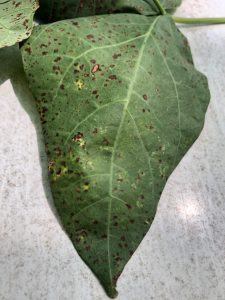
Snap Bean leaf with common bacterial spot – Image Credit Matthew Orwat, UF/IFAS Extension
As snap bean season is winding down and daytime temperatures regularly approach the lower 90s, common bacterial blight is making its presence known. In March or April, when snap bean plants are young and full of fresh growth, vegetable gardeners would never guess that their leafy plants could turn spotty and ugly during harvest time.
That is exactly what happens when daytime temperatures steadily remain in the mid-80s and low-90s, and nighttime temperatures are in the lower 70s. The perfect storm for this bacterial disease occurs when these temperatures combine with afternoon and evening showers, creating sticky, humid nights perfect for the proliferation of the causal agent, Xanthomonas campestris pv. Phaseoli.
Common bacterial blight begins showing up on older leaves first and then slowly spreads to younger growth and pods. If plants are left untreated, disease progression will continue if rainy nights and warm daytime temperatures continue. If weather conditions are consistently dry, daytime temperatures are above 90 and overhead irrigation is limited to mornings or eliminated, the blight will stop progressing to new growth. This disease may also be transmitted by insects.
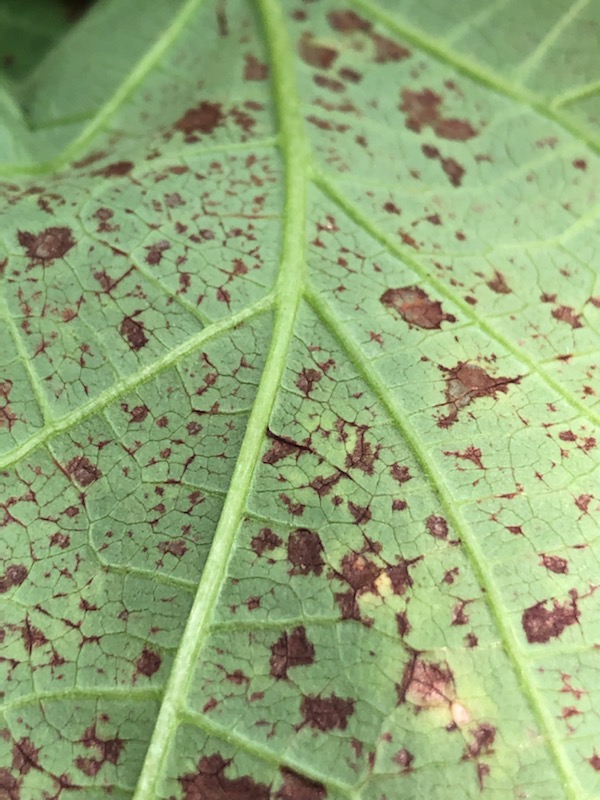
Note the brown, water-soaked spots on the underside of this leaf, typical of a bacterial infection – Image Credit Matthew Orwat, UF/IFAS Extension
If conditions favorable to common bacterial blight exist, preventative sprays of copper fungicide will work to
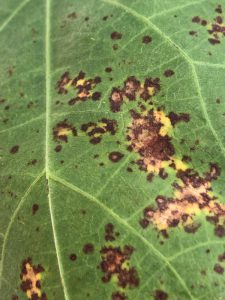
Snap Bean leaf with common bacterial spot – Closeup – Image Credit Matthew Orwat, UF/IFAS Extension
reduce infection and damage to crop, but there is no product to cure what has already been infected.
One of the best techniques available to manage common bacterial blight in beans is to rotate crops regularly so that legumes are not grown on the same ground year after year. This is easily accomplished in a diverse home garden with different raised beds or garden plots.
To learn more about common bacterial blight of bean follow these links to the NFREC Plant Pathology U-Scout page or read IFAS Extension PUBLICATION #PP-62
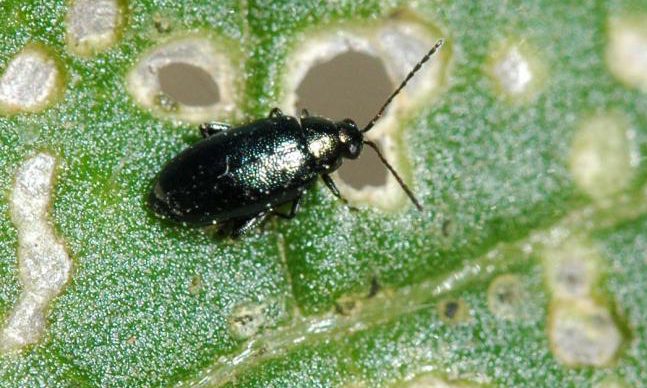
by Donna Arnold | Jun 9, 2022
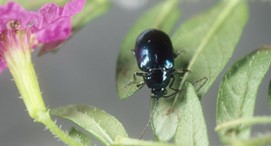
Photo credit Lyle J. Buss, UF/IFAS
The unwanted guest- Flea beetle
Having trouble with flea beetles? Tired of them showing up unannounced? Do not be alarmed here are a few tips to get rid of the unwanted guest in your garden.
Description: Flea beetles vary in appearance, where colors range from black to tan, with other, brighter colors mixed. They may also have a solid, striped, or spotted pattern depending on the species. Beetles are tiny with large hind legs which allow them to jump like fleas when disturbed.
Lifecycle: These unwanted guests will overwinter as adults in the soil or beneath plant debris and become active in early spring when temperatures reach 50°F, and begin feeding on weeds or early-planted crops. Eggs are laid by adult flea beetles normally around May in the soil or at the base of host plants. After 7-14 days eggs will hatch and larvae will feed and develop on various plant parts. They pupate in the soil for 11-13 days before emerging as adults.
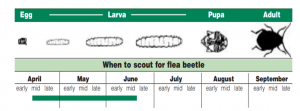
Host plants: Some species attack a wide range of plants, while others target only certain plant families. (Table 1). In the garden, several vegetable crops are eaten by these pests, particularly those in the Brassica family.
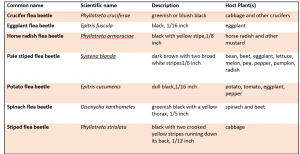
Table 1: Common flea beetles and host plants.
Scouting: Adult flea beetles are particularly active on warm, sunny days. To identify damages, scout every 1-2 days in newly planted fields, since it is easier to identify the damages than to see the beetles themselves. Flea beetle populations can be monitored with yellow sticky traps.
Damage: Adult beetles feed on foliage, producing shot holes in the leaves, especially new leaves which will have a lacy appearance. Additionally, in leafy crops like lettuce or spinach, the holes can reduce the quality of the leaves.
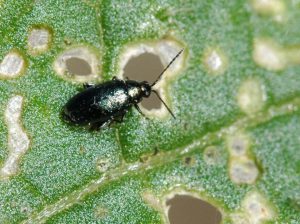
Photo Credits: Jeffery Hahn University of Minnesota
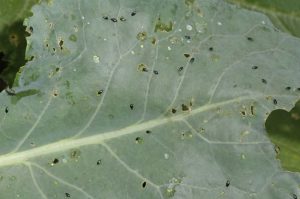
Photo Credit : Jeffery Hahn University of Minnesota.
Management / Control strategies:
- In the spring delay transplanting or planting by a couple weeks if possible.
- In the fall, till the garden to uncover any hiding flea beetles.
- Plant “push” or repellant crops such as catnip, sage, mint, hyssop, nasturtium, and basil.
- Use a “trap crop” such as radishes, taking the pest’ focus off more valuable plants.
- Dusting leaves with plain talcum powder repels flea beetles on tomatoes, potatoes, peppers, and other plants.
- Insecticides may be used early in the season.
- Water deters adult flea beetles. Any watering should be done in mid-day.
- Planting after adults have emerged or crop rotation can help minimize flea beetle damage.
- Apply commercially available nematodes that feed on flea beetle eggs, larvae, and pupae.
Supporting information for this article can be found in the UF/IFAS EDIS publications EENY-721/IN1238: Flea Beetles of the Genus Altica: Altica spp. (Insecta: Coleoptera: Chrysomelid) (ufl.edu); https://entnemdept.ufl.edu/creatures/ORN/BEETLES/flea_beetle.html and https://extension.uga.edu/content/dam/extension/programs-and-services/integrated-pest-management/documents/insect-pdfs/fleabeetles.pdf
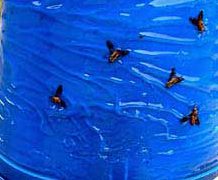
by Larry Williams | Jun 9, 2022
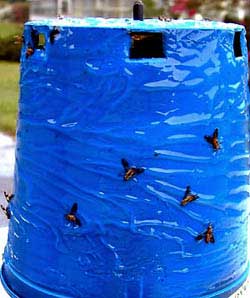
Deer fly trap. Photo credit: Russ Mizell
Recently, I’ve been asked about a deer fly trapping method that I wrote about a number of years ago. So, here it is. This aggravating insect is active now.
Deer flies, which are in the horsefly family, are annoying as they repeatedly and persistently dive for their victims until they inflict a painful bite.
Dr. Russ Mizell, now retired UF/IFAS Extension entomologist, experimented with a method to trap this insect. Mizell wanted to identify the optimum shape, size, color and speed to attract deer flies. If successful, he could temporarily remove a deer fly population long enough to enjoy an outdoor gathering without being bothered by deer flies.
Mizell said he started the research as a high school science project with his son but “it got so interesting, I just kept doing it.”
Deer flies wait for prey to walk before attacking. So, they are highly attracted to movement.
With this in mind, Mizell and his son decided the best way to snare deer flies was to “troll” for them from a slow-moving vehicle. Working in spring and summer when deer flies are most prominent, they set out to discover what kind of trap worked best.
They built a test platform on the hood of their vehicle that could troll seven different shapes at once. They ambled along in deer fly-infested countryside for set periods of one to five minutes, testing pyramids, squares, balloons, plant containers and other shapes, all coated with Tanglefoot (commercially available sticky spray for insects), then counting immobilized prey. They tried black, tan, blue and shapes of other colors suspended from various heights.
The trap that enticed the most deer flies proved to be a 6-inch flowerpot painted bright blue and coated with Tanglefoot. This trap captured as many as 30 deer flies in a one-minute test. It worked best when suspended three to six feet above the ground and trolled no faster than 10 feet per second or about 7 miles per hour.
The traps are remarkably effective, Mizell said. “Many times, after running the traps through an area, we found there were no deer flies left,” he said. “You trap them out for a short period until they repopulate the area.”
The traps also work when attached to a baseball cap and trolled by the hat’s wearer. But instead of attaching a flowerpot to your cap, you could attach a blue drink cup painted with Tanglefoot.
Despite its effectiveness, its aesthetic appeal leaves something to be desired.
For more information including instructions and pictures of how to make a deer fly trap visit the below site. http://entomology.ifas.ufl.edu/pestalert/deerfly.htm
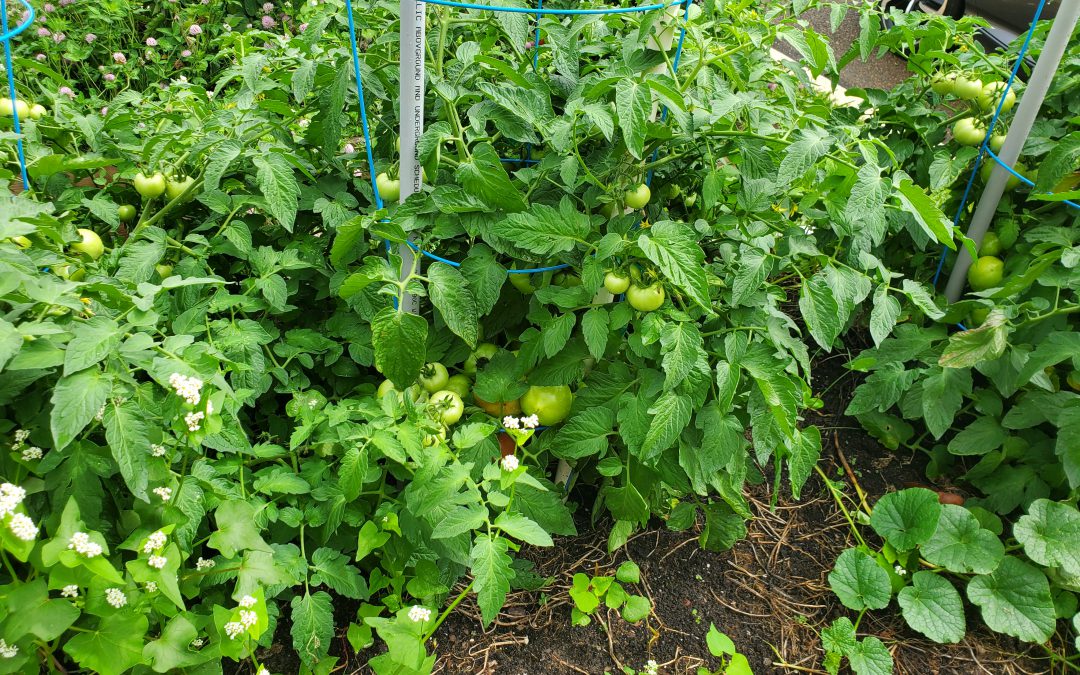
by Daniel J. Leonard | Jun 8, 2022
2022 has been a good tomato growing year for many Panhandle gardeners, myself included. It would have been difficult to have better climatic conditions to aid a terrific tomato harvest. After enduring a late frost just before Easter, the Panhandle then experienced two mild months in April and May that combined with nearly a month of dry weather during fruit development to deliver an excellent fruit set season with minimal disease and insect pressure. However, despite the favorable growing conditions, I have talked with several gardeners that once again struggled to yield a good crop of fresh garden tomatoes. Why is that? With the Panhandle tomato home gardening season nearing its conclusion, now is a perfect time to revisit 3 of the most common mistakes that prevent an excellent harvest!
Not Starting Early – Since Memorial Day, the rain and heat have really ramped up. These hot, wet conditions are perfect for developing tomato plant problems like fungal and bacterial diseases, not to mention the fact that tomato plants will stop setting fruit once nighttime temperatures rise above 75 F. While spraying fungicides preventatively can certainly help decrease disease incidence, the absolute best thing a gardener can do is try to get ahead of the disease-bringing heat and humidity by starting plants early when more favorable growing conditions prevail. So, what is early? I try to have tomato transplants in the ground by March 15 or soon after*. If you plan to grow plants from seed, they should be started indoors mid-January for planting outdoors in mid-March. Most tomato varieties take between 60 and 80 days to mature after planting, so a mid-March planting date normally yields harvestable tomatoes by the middle of May, comfortably beating the June disease deadline. *Planting early means protecting plants from occasional late frosts. Be prepared!
Not Scouting Your Plants – Pest and disease problems are a lot easier to manage if caught early and the best way to do that is to spend time with your plants. If you scout (just walking by and giving plants a short inspection) daily, you’ll learn what tomato plants and the beneficial insects that hang around all the time are supposed to look like an and be able to spot abnormalities and bad bugs when they occur. While tomato diseases and pest outbreaks can certainly cause a lot of damage in a short amount of time, they don’t reach disastrous levels immediately – be vigilant and catch them early!
Not Fertilizing and Watering Correctly – It takes a lot of energy for a tomato plant to grow a nice, bushy plant AND yield an abundance of America’s favorite vegetable (or fruit, depending on who you ask). To produce that necessary energy, gardeners must ensure plants receive adequate nutrition and water. Here’s my general prescription. At planting, apply a general purpose, slow-release fertilizer according to the label rate (for example, Osmocote, Harrell’s, or similar) and gypsum (a calcium supplement that helps prevent blossom end rot) at one pound per hundred square feet of garden. Then, supplement later in the season with a quick-release general purpose fertilizer sufficient to drive growth and fruit development. Watering is more of an ongoing concern. For the first couple of weeks of the tomato plant’s life, you can get by with watering once a day or every other day. As the plants get larger and the days get hotter however, watering twice daily is often needed to prevent wilting down in the heat of the day. Allowing tomato plants to wilt, even for a little while, is an excellent way to encourage blossom end rot and a subpar harvest!
When tomato season rolls around in 2023, remember to start early, scout often, and water and fertilize correctly. Follow those few tips and you’ll be well on your way to a great harvest in 2023! For more information about growing tomatoes or any other horticultural or agricultural topic, contact us at the UF/IFAS Calhoun County Extension Office at 850-674-8323 or email d.leonard@ufl.edu. Happy Gardening!
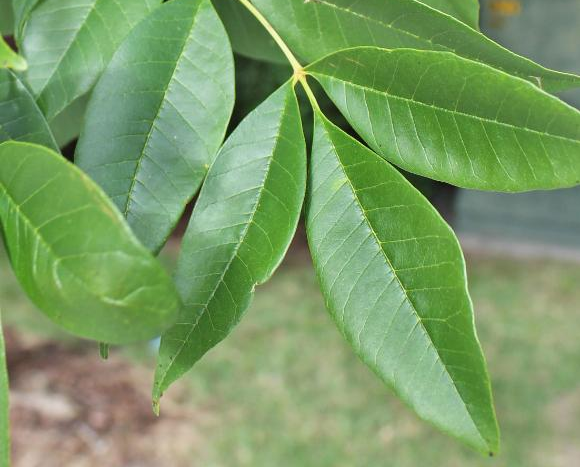
by Daniel J. Leonard | Jun 2, 2022
The Oracle of Omaha, Warren Buffett, once said “Someone is sitting in the shade today because someone planted a tree long ago.” While that’s all fine and good and I’m happy that the next generation gets to enjoy the things we grew, most of us would like to enjoy shade in our lifetimes too! If you too want to plant your own shade, one of the best rapidly growing shade tree choices for the Panhandle is the majestic Florida native Green Ash (Fraxinus pennsylvanica).

Green ash trees have a vase shape form. Photo Credit: University of Florida/IFAS
Green Ash is a large (50-100’ tall), oval-shaped, deciduous shade tree native to the entire eastern half of North America, but best of all for those of us craving shade, it grows to its mature height in a relative hurry. While most trees that grow extremely fast tend to be inherently weak and short-lived, this is not the case with Green Ash. Capable of growing 6-10’ in a single year if irrigated and fertilized appropriately and often living well over 100 years, there aren’t many plants in the Panhandle that grow quicker or live longer.
There’s much more to Green Ash than growth rate and life span, however. The tree is also one of the prettiest around. Come on, you didn’t think I’d recommend an ugly plant, did you? A look up into the canopy at different times of the year and one can see the tree’s deep, dark green foliage, good-for-Florida yellowish fall color, and slightly showy light green seed pods. Below, the straight trunk is laced with distinctive diamond-shaped bark that hints at the extremely high-quality wood underneath. Fun fact, Ash is historically the most popular wood used to make baseball bats due to its hardness at a relatively light weight – more MLB home runs have been hit with Ash than any other species!
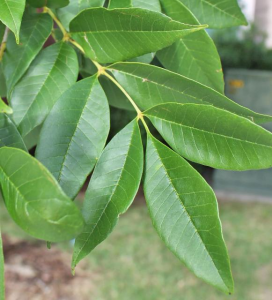
The compound leaf of a green ash tree. Photo Credit: University of Florida/IFAS
As a Florida-Friendly plant, Green Ash is fairly low-maintenance and provides many environmental services. The species, like any other plant, requires supplemental water and fertilizer during the establishment period, generally the first year or so after planting, but doesn’t demand much else from gardeners after that. Green Ash specimens in Florida also don’t have much in the way of pest problems (the invasive Emerald Ash Borer has devastated ash populations in northern states but thankfully has not yet been found in Florida). However, as a host plant for several native pollinators, including the Eastern Tiger Swallowtail, Mourning Cloak, Orange Sulphur, and Viceroy Butterflies, you may occasionally find caterpillars munching away on the tree’s foliage. If you can handle a little leaf damage, try to leave any caterpillars alone and enjoy the stunning butterflies they later morph into!
Green Ash is a beautiful, ultra-adaptable shade tree. Though the species prefers moist areas, there aren’t many sites the tree can’t thrive in. Do you have a low-lying area near a swamp or stream that stands in water from time to time? Great! Green Ash will thrive. Do you need a street tree to survive in a harsh environment with a cramped root zone surrounded by concrete? Green Ash will be right at home there as well. Green Ash is simply a classic shade tree with many interesting attributes that improves the look of any landscape it occupies. Plant one today!
For more information about Green Ash, other shade tree species, or any other horticultural/agricultural topic, contact us at the UF/IFAS Calhoun County Extension office.
















